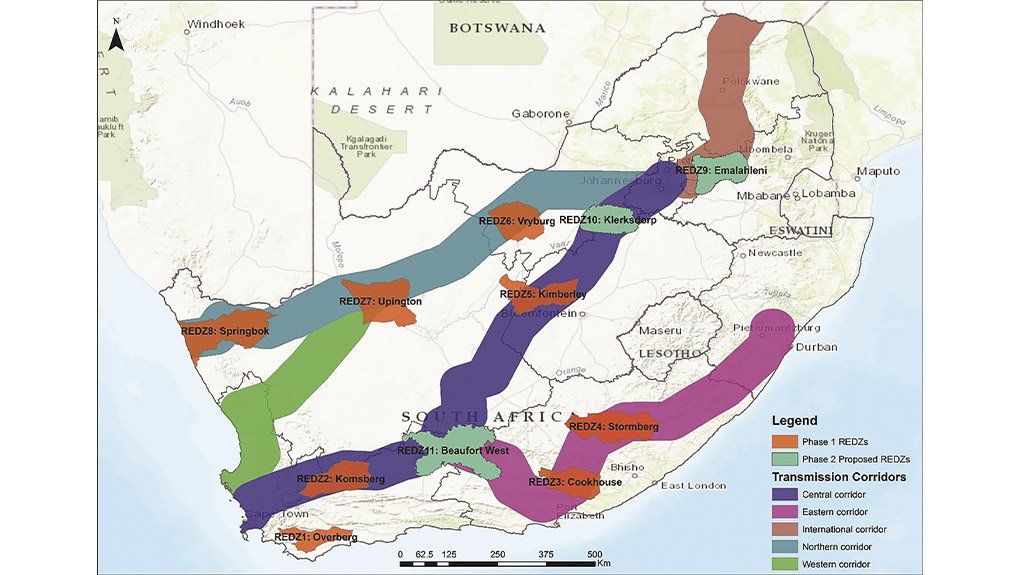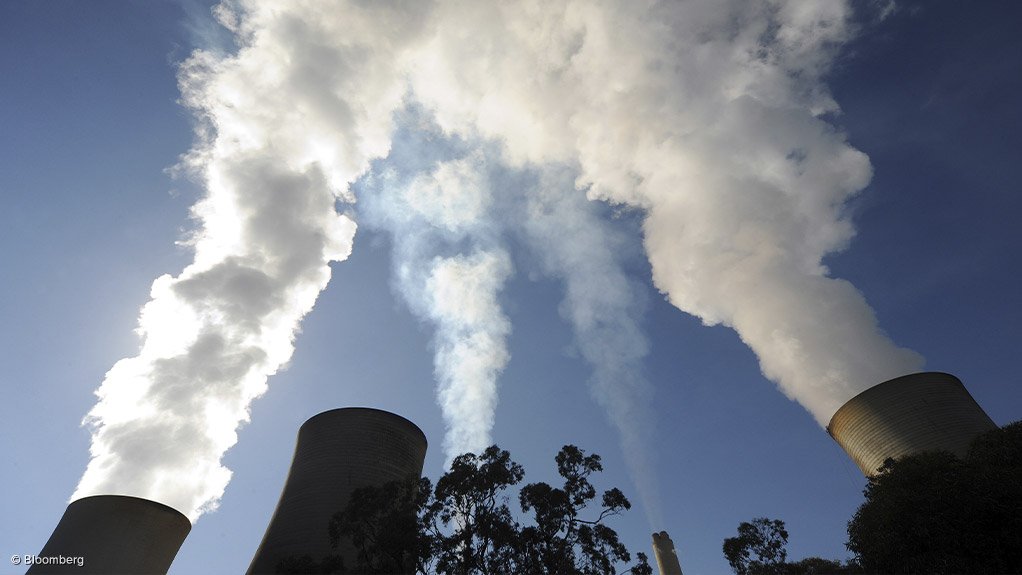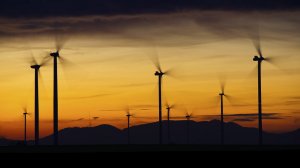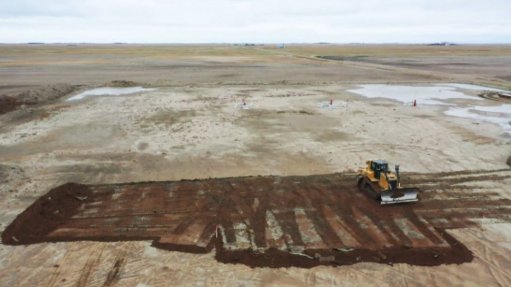Additional renewable energy development zones proposed




RENEWABLE ENERGY DEVELOPMENT ZONES The Phase 2 proposed zones support the responsible implementation of the Integrated Resource Plan 2019
CLEARING THE AIR Areas where coal-fired power plants are scheduled for decommissioning could be prime spots for new renewable energy projects
Photo by Bloomberg
WINDS OF CHANGE Planning for renewable energy projects in previously mined areas will play a role in the just transition to a low-carbon economy
The second phase of the Strategic Environmental Assessment for wind and solar photovoltaic (PV) energy in South Africa proposes three additional renewable energy development zones for wind and solar PV energy projects.
The renewable energy development zones support the responsible implementation of the Integrated Resource Plan (IRP 2019) that was gazetted by Mineral Resources and Energy Minister Gwede Mantashe in October.
Renewable energy projects that could be developed in these new renewable energy development zones have the potential to make significant contributions to mine rehabilitation and to support a just energy transition in the specified areas including where 12 GW of existing coal power stations are planned to be decommissioned by 2030.
The IRP 2019 has identified the requirement for at least an additional 14.4 GW of wind and 6 GW of solar PV by 2030 among a range of other new-build capacity including coal, gas, imported hydro and storage.
There is a distinct need for rehabilitating areas where existing coal power stations are expected to decommission and possibly repurposing these areas for a range of diverse economic activities including renewable energy deployment which can be fast-tracked if within the new renewable energy development zones.
The outcomes of the second phase of the Strategic Environmental Assessment for wind and solar PV energy in South Africa were presented to stakeholders at the Council for Scientific and Industrial Research (CSIR), in Pretoria, in September. This study was commissioned by the Department of Environment, Forestry and Fisheries.
The two new renewable energy development zones for PV are in the eMalahleni and Klerksdorp areas, and the third one, which focuses on wind energy, is located to the east of Beaufort West.
During the event, CSIR environmental scientist Abulele Adams conveyed that one of the main aims of the Phase 2 Strategic Environmental Assessment was to identify previously mined areas close to Gauteng, where the highest demand for energy is, to incentivise large-scale solar PV projects in this area.
“In this way, the new renewable energy projects can contribute towards the rehabilitation of previously mined areas, support job creation in the areas, especially where there may be a decline in mining, and potentially make use of existing infrastructure, such as the electricity grid and roads from previous mining activities,” she explained.
She further emphasised that it is important to plan renewable energy development in these previously mined areas to ensure that renewables play a role in the just transition to a low-carbon economy.
The identification of the new renewable energy development zones involved positive mapping – also known as “pull factors” – which included factors such as the abundance of the existing wind and solar PV energy resources, access to the power corridors, and other technical criteria required for renewable energy facilities.
This was followed by negative mapping – also known as “push factors” – which involved taking into account environmental features and areas that are sensitive to the placement of large-scale wind and solar PV facilities for instance.
Thereafter, an industry prioritisation exercise was conducted to ensure that the proposed areas are aligned with areas that the renewable energy sector identified as priorities for future projects.
CSIR environmental assessment practitioner Paul Lochner highlighted that renewable energy development can still take place outside of the renewable energy development zones.
“Such applications must be considered on a project-by-project basis,” he explained.
He added that the renewable energy development zones are also aligned with the powerline corridors that were identified in the Electricity Grid Infrastructure Strategic Environmental Assessment completed in 2016 and gazetted as powerline corridors in February last year.
In this way, the combination of the renewable energy development zones and power corridors provides strategic guidance to State-owned power utility Eskom on where to prioritise investment in grid infrastructure.
This Phase 2 Strategic Environmental Assessment follows the Phase 1 Wind and Solar Strategic Environmental Assessment – completed in 2015 – which identified eight renewable energy development zones in South Africa. These were gazetted for implementation by then Environmental Affairs Minister Edna Molewa, in February last year.
The objective of the Strategic Environmental Assessment is to identify areas in the country that are best suited for wind and solar PV energy projects, based on a holistic assessment of technical, strategic planning, environmental and socioeconomic criteria.
Article Enquiry
Email Article
Save Article
Feedback
To advertise email advertising@creamermedia.co.za or click here
Comments
Press Office
Announcements
What's On
Subscribe to improve your user experience...
Option 1 (equivalent of R125 a month):
Receive a weekly copy of Creamer Media's Engineering News & Mining Weekly magazine
(print copy for those in South Africa and e-magazine for those outside of South Africa)
Receive daily email newsletters
Access to full search results
Access archive of magazine back copies
Access to Projects in Progress
Access to ONE Research Report of your choice in PDF format
Option 2 (equivalent of R375 a month):
All benefits from Option 1
PLUS
Access to Creamer Media's Research Channel Africa for ALL Research Reports, in PDF format, on various industrial and mining sectors
including Electricity; Water; Energy Transition; Hydrogen; Roads, Rail and Ports; Coal; Gold; Platinum; Battery Metals; etc.
Already a subscriber?
Forgotten your password?
Receive weekly copy of Creamer Media's Engineering News & Mining Weekly magazine (print copy for those in South Africa and e-magazine for those outside of South Africa)
➕
Recieve daily email newsletters
➕
Access to full search results
➕
Access archive of magazine back copies
➕
Access to Projects in Progress
➕
Access to ONE Research Report of your choice in PDF format
RESEARCH CHANNEL AFRICA
R4500 (equivalent of R375 a month)
SUBSCRIBEAll benefits from Option 1
➕
Access to Creamer Media's Research Channel Africa for ALL Research Reports on various industrial and mining sectors, in PDF format, including on:
Electricity
➕
Water
➕
Energy Transition
➕
Hydrogen
➕
Roads, Rail and Ports
➕
Coal
➕
Gold
➕
Platinum
➕
Battery Metals
➕
etc.
Receive all benefits from Option 1 or Option 2 delivered to numerous people at your company
➕
Multiple User names and Passwords for simultaneous log-ins
➕
Intranet integration access to all in your organisation



















